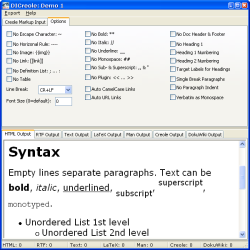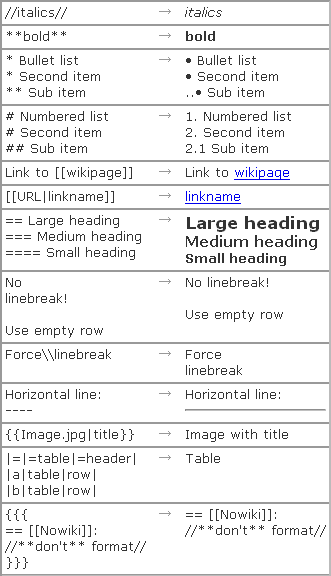Table of Contents
DICreole
Overview
 The Creole markup language is based on extensive research on common wiki markup elements and developed at http://www.wikicreole.org/. It is mostly designed for Wiki systems in mind, but network and standalone applications can also benefit from its simple but powerful markup language:
The Creole markup language is based on extensive research on common wiki markup elements and developed at http://www.wikicreole.org/. It is mostly designed for Wiki systems in mind, but network and standalone applications can also benefit from its simple but powerful markup language:
- Information systems.
- Software documentation.
- Database documents.
DICreole includes ready-made converts for these output formats:
- HTML
- RTF
- Text
- LaTeX
- Man
- Creole
- DokuWiki
Developers can modify existing and add new output formats as desired.
Text Formatting Rules
Text with markup is plain text with a few character sequences which are recognized by the markup processor and change the format of the result. The result is styled text with titles, paragraphs with justification, bold and italic faces, etc.
There are two kinds of markup constructs: blocks and inline. Blocks are paragraphs (indented or not), headings, list items, table cells, horizontal rules and block extensions. Inline constructs are character styles, verbatim text and links; they are part of blocks. Except in preformatted blocks, sequences of spaces or tabs are replaced with single spaces.
Paragraphs
Paragraphs are made of lines whose first character is not one of *#:;= nor sequence {{{, ----, or <<<. Lines can begin with sequences ** and ##.
Paragraphs end with blank lines or next heading, list, table, indented paragraph, preformatted block of text, horizontal rule or block extension. They can contain styled text, links, spans of verbatim text, and inline extensions.
Example:
This is a paragraph written in two lines. This is another paragraph.
Indenting
Indented paragraphs are paragraphs which begin with a colon. The colon must be the first character of the line. Multiple colons define the level of indenting. Indented paragraphs can contain styled text, links, spans of verbatim text, and inline extensions.
Example:
This is a normal paragraph. :This is an indented paragraph in two lines. ::This is more indented.
Headings
Headings are made of a single line beginning with an equal character. The number of equal characters defines the level of title, from main title (=) to sub-sub-subtitle (====). Headings may end with a sequence of equal characters.
Example:
=Level 1 heading= Paragraph =Another level 1 heading, without trailing equal character ==Level 2 heading== ===Level 3 heading===
Lists
Lists are collections of items. There are three kinds of lists: unnumbered lists, numbered lists, and definition lists. Lists can be nested; they end with the next heading, indented paragraph, table, or blank line.
Unnumbered lists are represented as indented paragraphs with a bullet. Each item begins with a star character (*); it can span multiple lines.
Numbered lists are represented as indented paragraphs with a number. Items are numbered automatically with consecutive integers starting at 1. Each item begins with a sharp character (#); it can span multiple lines.
Definition lists are made of two kinds of items: title, typically displayed in bold font, and definition, typically displayed indented. Titles begin with a semicolon at the beginning of a line. Definitions either follow the title, separated with a colon; or they begin on a new line beginning with a colon.
List nesting can combine different kinds of lists. Sublist items begin with multiple markers, the first one(s) corresponding to the enclosing list(s). For instance, items of an unnumbered list nested in a numbered list should start with #* at the beginning of the line, without any preceding space. For clarity, list markers should be used in a consistent way; but only the first item of each list fixes the kind of the whole list.
Example:
* First item of unnumbered list. * Second item, in two lines. *Third item without space (spaces are optional). # First item of numbered list. # Second item. #* First item on unnumbered sublist. #* Second item. # Thirst item of top-level numbered list. ; First title of definition list : Definition of first item. ; Second title: Second definition beginning on the same line. Paragraph separated with a blank line.
Tables
Tables are rectangular array of cells. They are made of one line per row. Each cell begins with character |. Heading cells (typically displayed in bold face) begin with |=. Rows may end with a trailing |.
Example:
In the table below, the first row and the first column contain headings. The very first cell is empty.
||=First column|=Second column |=First row|Cell 1,1|Cell 1,2 |=Second row|Cell 2,1|Cell 2,2
Preformatted
Preformatted text is a block of text displayed literally, including line feeds. Preformatted text is preceded with a line containing {{{ and is followed by a line containing }}}.
Example:
This is some C code:
{{{
double f(double x)
{
return 2 * x; // f(x) = 2x
}
}}}
In preformatted text, lines which begin with }}}, with leading spaces or not, must have an additional space which is discarded in the output.
Horizontal rules
Horizontal rules are single lines containing four hyphens.
Example:
Paragraph. ---- Paragraph following a horizontal rule.
Extensions
Sequences << and <<< are reserved for extensions.
Character style
Inside paragraphs, indented paragraphs, headings, list elements, and table cells, the following two-character sequences toggle on or off the corresponding style. It is not mandatory to nest spans of styled characters between matching style sequences. Style is reset at the end of text block.
| Markup | Style |
|---|---|
** | Bold |
// | Italic |
## | Monospace |
,, (two commas) | Subscript |
^^ | Superscript |
__ (two underscores) | Underlined |
Double stars and double sharps are interpreted as the beginning of list items when they are the first characters of a line in the context of lists. To be interpreted as style markup, they can be preceded by a space.
Example:
This is //italic text//, **bold text**, and //**bold italic text**//.
Escape character
The tilde character, when followed by any character except space, tab or line feed, is an escape character; it is not displayed and the next character loses its special meaning, if any.
Example:
Two stars: ~*~* or ~** or *~*; tilde: ~~.
is rendered as “Two stars: ** or ** or **; tilde: ~.”
Verbatim
Verbatim text is a sequence of characters enclosed between {{{ and }}}. After {{{, all characters are output verbatim, without any markup interpreting, until the next }}} or the end of text block. Multiple spaces and tabs and single line feeds are still converted to single spaces, though. Verbatim text is an alternative to the escape character; it is more convenient for sequences of characters.
Example:
{{{**}}} //{{{{{{xx}}}}}}//
is rendered as “** {{{xx}}}”.
Line break
Except in preformatted blocks, line breaks are not preserved. The sequence \\ forces a line break.
Example:
The next line of this paragraph begins...\\here!
Links
Hypertext links (URLs) are enclosed between [[ and ]]. The text displayed as the link is either the same as the URL itself if there is no | character, or it is what follows |. No markup is recognized in the URL part; what follows | can contain styled text and verbatim text. Spaces surrounding | are ignored.
Examples:
* Simple link: [[https://www.yunqa.de/delphi/]] * Link with link text: [[https://www.yunqa.de/delphi/|Delphi Inspiration]] * Link with styled link text: [[https://www.yunqa.de/delphi/|**Delphi Inspiration**]]



